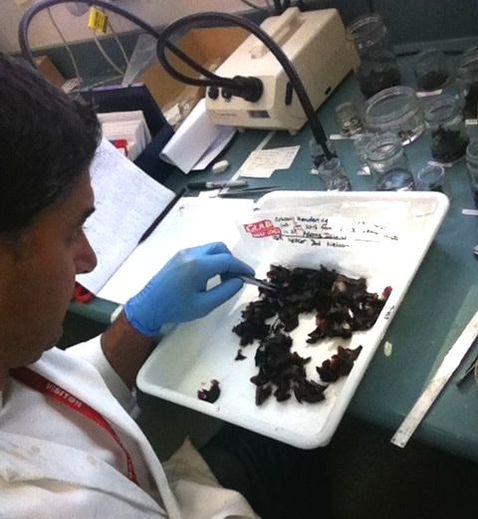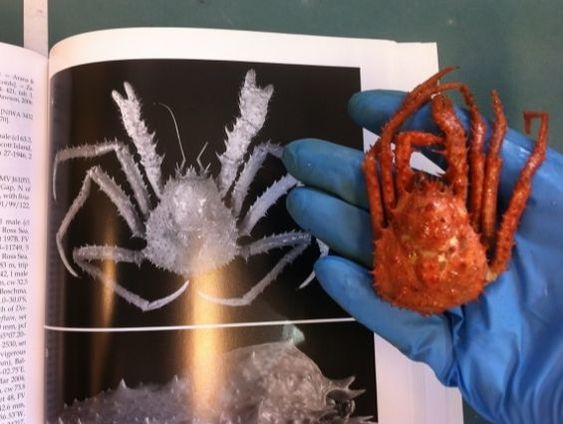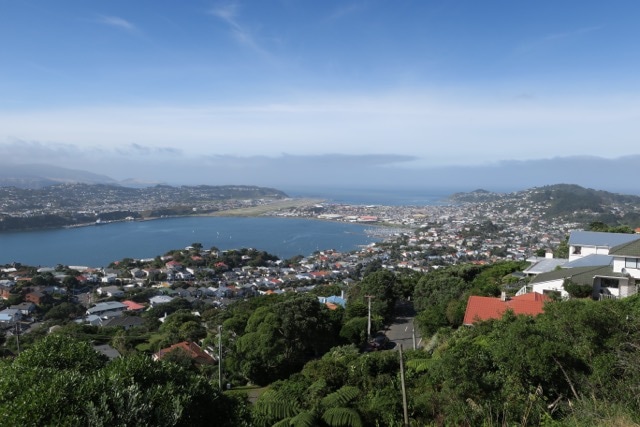DIÁRIOS DE CAMPANHA
|
|
DIÁRIOS DAS ATIVIDADES DE CAMPO DOS PROJETOS DURANTE A CAMPANHA PROPOLAR 2016-2017
Quanto temos um grande desafio dizemos que “temos uma montanha pela frente!”. No meu caso, eu tinha um caso bicudo. Tinha 40 amostras (20 de cada albatroz, Diomedea gibsoni e Diomedea antipodensis) acabadas de chegar aqui ao instituto em Wellington, Nova Zelândia. Nessa altura ainda não sabia que esta seria “a minha montanha”. Com pouco tempo disponível no laboratório, deu para compreender que tinha um autêntico Everest à minha frente, pois estava a demorar muito tempo a analisar apenas 3-4 amostras por dia (a chegar ao lab. às 8.30 e sair às 6 da tarde, seguindo as regras de segurança do instituto em relação ao uso dos laboratórios), com cada amostras com 400 a 500 bicos de cefalópodes para analisar. Isso significa limpar cada bico, separar entre os bicos de cima e os bicos de baixo (cada lula ou polvo, possui um de cada), identificar e medir todos os bicos de baixo, além de preservar amostras para estudos futuros. Com o tempo a reduzir-se significativamente antes de regressar à Europa, a solução foi pedir ao instituto para poder trabalhar no fim de semana. Assim, nestas 2 últimas semanas não existiu a possibilidade de reduzir de ritmo de trabalho...foi sempre “subir a montanha”. Felizmente durante esse fim de semanas acabei as primeiras 20 amostras do albatroz Diomedea antipodensis, no entanto não saberia como seriam as restantes 20 amostras da outra espécie. Seriam tão complicadas com as primeiras? Para minha alegria, estas 20 últimas amostras aparentemente continham um número muito mais reduzido de bicos...nessa altura senti que estava “no topo da montanha a ver o horizonte!” Nos 2 dias seguintes consegui terminar estas amostras, comparativamente com mais de 1 semana para as primeiras...estava literalmente no fim da “descida da montanha”!!! Esta semana tive também de acabar de identificar uns crustáceos com os colegas de cá da dieta do bacalhau da Antártida, do projeto de mestrado do José Queirós, e passar 2 dias a concluir muito do trabalho pendente (vocês sabem: muitos emails, artigos para rever,...). Será sempre assim, perguntam vocês, a trabalhar com pouco tempo para mais nada? Não. Existe tempo para “aproveitar o passeio pela montanha”. Como sou otimista, este desafio também me ajuda sempre a refletir das coisas boas que temos junto de nós. Desde que cheguei, emprestaram-me uma bicicleta que tem feito a minha delicia todos os dias para chegar ao instituto (e Wellington é uma cidade linda para passear). Deu para rever e conhecer amigos de cá, incluindo Portugueses do melhor que temos, para ir ao cinema, para explorar a cidade, para deliciar-me com os gelados, ir ver as ondas em Lyall Bay (ainda vi um surfista mas as ondas estavam um pouco pequenas), tudo isto a tentar cuidar das saudades da família e amigos por facebook, skype...concluindo: no meio do meu percurso “a subir a montanha”, é sempre importante manter a alegria de fazer ciência, e principalmente perceber o que nos faz felizes. Agora olho para trás e vejo a montanha lá longe, com um sorriso... When we have a big challenge we say “we have a mountain in front of us!”. In my case, I had a very complicated 40 samples (20 from each albatross, 'Diomedea gibsoni' and 'Diomedea antipodensis') that recently arrived at the institute in Wellington, New Zealand to be analysed. At that time I did not know that this would be “my mountain” to climb. With little time available in the lab., it became obvious that I had the “Everest” in front of me, as I was taking considerable more time that expected to analise 3-4 samples per day (arriving in the lab. at 8.30am and leaving at 6pm, following NIWA laboratory regulations), with each containing up to 400-500 beaks. For each sample, it is necessary to clean each beak, separate upper from lower beaks (each squid or octopus has a 1 of each), identify and measure all lower beaks and preserve all beaks for future studies. With time getting shorter and shorter before returning back to Europe, the solution was to request the institute to work during the weekend. Therefore, in the last 2 weeks, there was no time to reduce the pace of work, working during the weekend....I was literally “climing the mountain”. Happily, during that weekend I finished the first 20 samples, however I did not know how much time would the final 20 samples from 'D. gibsoni' would take. Would they be the same nightmare as before (i.e. another mountain?)? You should have seen my face of happiness when realized that these final samples contained far less beaks ...at that time I felt I was “at the top of the mountain looking at the lanscape and to the horizon!” In the following two days all samples were analised, far less than 7 days for the first 20 samples...I was literally going “fast down the mountain”.
0 Comentários
O seu comentário será publicado depois de ser aprovado.
Deixe uma resposta. |
DIÁRIOS DA CAMPANHA
|



 Feed RSS
Feed RSS
